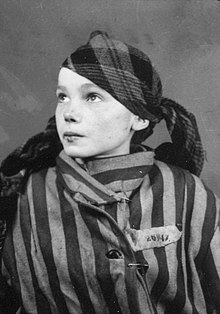Penculikan anak oleh Jerman Nazi
Tampilan
 Surat dari kantor Lebensborn kepada keluarga Reichsdeutsche Herr Müller di Jerman memberitahukan soal penemuan dua anak laki-laki sempurna. Nama anak-anak tersebut di-Jermanisasi-kan, 18 Desember 1943 | |
| Anak-anak asing yang diculik | |
|---|---|
| Wafat saat transit, yang diperkirakan berjumlah sepuluh ribu, dan tahanan di bawah umur dipakai sebagai sumber suplai buruh, tak didaftarkan |

Penculikan anak oleh Jerman Nazi (bahasa Polandia: Rabunek dzieci), bagian dari Generalplan Ost (GPO), melibatkan pengambilan anak-anak yang dipandang "berpenampilan Arya" dari seluruh belahan Eropa dan memindahkan mereka Jerman Nazi untuk tujuan Jermanisasi, atau indoktrinasi agar menjadi orang Jerman budaya.
Dengan jumlah lebih dari 200.000 korban, kawasan pendudukan Polandia memiliki jumlah terbesar dari anak-anak yang diambil.[2][5] Sekitar 400.000 anak-anak diculik di seluruh belahan Eropa.[1]
Catatan
[sunting | sunting sumber]- ^ a b Gitta Sereny, "Stolen Children", rpt. in Jewish Virtual Library (American-Israeli Cooperative Enterprise). Accessed September 15, 2008. (Reprinted by permission of the author from Talk [November 1999].)
- ^ a b Volker R. Berghahn, "Germans and Poles 1871–1945", in Germany and Eastern Europe: Cultural Identities and Cultural Differences. New York and Amsterdam: Rodopi, 1999.
- ^ Kesalahan pengutipan: Tag
<ref>tidak sah; tidak ditemukan teks untuk ref bernamaKnoll - ^ a b Kesalahan pengutipan: Tag
<ref>tidak sah; tidak ditemukan teks untuk ref bernamaMoses260 - ^ A. Dirk Moses (2004). Genocide and Settler Society: Frontier Violence and Stolen Indigenous Children in Australian History. New York and Oxford: Berghahn Books, 2004. hlm. 247. ISBN 978-1-57181-410-4. Diakses tanggal 2008-09-16. Limited preview. Google Books.
Referensi
[sunting | sunting sumber]- Hrabar, Roman Z., Zofia Tokarz, and Jacek E. Wilczur. The Fate of Polish Children During the Last War. Trans. Bogdan Buczkowski and Lech Petrowicz. Rada Ochrony Pomników Walki i Męczeństwa. Warsaw: Interpress, 1981. ISBN 83-223-1950-9 (10). ISBN 978-83-223-1950-5 (13).
- Milton, Sybil. "Non-Jewish Children in the Camps". Museum of Tolerance, Multimedia Learning Center Online. Annual 5, Chapter 2. Copyright © 1997, The Simon Wiesenthal Center. Accessed September 25, 2008.
- Richard C. Lukas, Did the Children Cry? Hitler's War against Jewish and Polish Children, 1939-1945. Hippocrene Books, New York, 2001
- Nuremberg Trials Project: Overview Diarsipkan 2016-02-08 di Wayback Machine. and Nuremberg Trial Documents Bibliography Diarsipkan 2009-01-25 di Wayback Machine. and Nuremberg Trial Resources Diarsipkan 2009-01-25 di Wayback Machine. – Nuremberg Trials Project: A Digital Document Collection at Harvard University Law School Library (HLSL). ["Contents of the Collection: The Nuremberg Trials collection fills some 690 boxes, with an average box containing approximately 1500 pages of text (for a total estimated at 1,035,000 pages). The three largest groups of documents are: trial documents (primarily briefs and document books for trial exhibits) for the twelve NMT trials and the IMT trial (280 boxes); trial transcripts for the twelve NMT trials and the IMT trial (154 boxes); and evidence file documents (the photostats, typescripts, and evidence analyses from which the prosecution, and occasionally defendants, drew their exhibits) (200 boxes). ... The HLSL collection also includes documents from the IMT hearings on criminal organizations and miscellaneous papers concerning the trials. Most of the documents are in both English and German (and occasionally other languages). ... In this project only the English language trial documents and trial transcripts will be presented, but the evidence file documents are usually in both English and German."]
- "The RuSHA Case: D. Kidnapping of Children of Foreign Nationality: 3. Polish Children" (inactive URL). Cf. "The RusSHA Case: di Archive.is (diarsipkan tanggal June 12, 2007) D. Kidnapping of Children of Foreign Nationality: 3. Polish Children" (Internet Archive URL). 993–1028 in Trials of War Criminals Before the Nuernberg [sic] Military Tribunals Under Control Council Law No. 10. © Mazal Library, n.d. NMT04-C001. Nuernberg [sic] Military Tribunal, Vol. IV, Pages VII — VIII: "The RuSHA Case". Diarsipkan December 6, 2012, di Library of Congress Web Archives. mazal.org. Accessed September 15, 2008. (Trial documents.) [Note: "The Trials of War Criminals before the Nuernberg Military Tribunals (NMT) differ from the Trial of the Major War Criminals before the International Military Tribunal (IMT) in a number of different ways...."]
Pranala luar
[sunting | sunting sumber]- "The 'Lebensborn' Program (1935–1945)". Jewish Virtual Library (American-Israeli Cooperative Enterprise). ("Sources: The Forgotten Camps; ABC News 20/20 Special Report — Hitler's 'Master Race': Nazi Program Attempted to Create Racially Pure Children (April 27, 2000).") [Includes an illustration of a kidnapping.]
